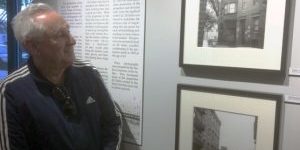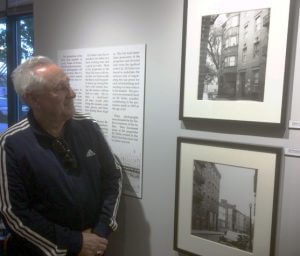Ira Tarlin: Recollections from the Son of a West End Landlord
For many years prior to the demolition of the West End, Ira Tarlin ran an extensive real estate business in the neighborhood. His story, and that of others who owned and managed properties in the community, is rarely told as part of the urban renewal narrative. But, the fact is that they suffered greatly, receiving just pennies on the dollar for their buildings and enduring incredible hardships.
When Ira Tarlin, Eli’s son, donated a small collection of his family’s photographs to The West End Museum last summer, he gave the Museum the opportunity to convey that piece of the puzzle. The Tarlins were devastated by the loss of the West End and the resulting demise of the family business. Recently, Ira took time to share with us his family’s history and memories the old neighborhood. What follows are highlights from that conversation.
Tell us about your father.
My dad was in the real estate business in the West End and owned property throughout the neighborhood. He was a broker, property manager, owner, auctioneer and appraiser. He grew up in Dorchester and worked with his father in the real estate business there, but his dad also had an office in the West End, so he became associated with that community as well. Their office was on Leverett Street.
Did you grow up in Dorchester?
No, I grew up in Brighton, but I often went to the West End to visit my father, so I became familiar with the streets and some of the properties. My uncles would take me, and my brother would take me occasionally. Sometimes, my father would come and get me on Sundays. He used to light a stove in the office on Sundays so it would be warmer when he went in on Mondays.
What do you recall of the final days of the West End in the 1950s?
I was a youngster. The end for my dad was in 1958. He had a property outside of the West End that he moved his office to, a mixed-use property in Somerville. But shortly thereafter—in December 1959—he passed away. I’m not sure if the West End Urban Renewal Project killed him, but I suspected that as I got older. He was there a long time, since around 1922, [when he] was associated with his Dad. That’s when he began his career in real estate. I think it was very hard. He was very used to it. He liked to go there. He liked to deal with the people there. I guess it was kind of in his blood.
Where in the old West End did your father own and manage properties?
He owned property on different streets: Leverett Street, Billerica Street, Causeway Street…they were all antique dealers on Causeway Street. He owned some of the storefronts there. He also owned property on Chambers Street, Brighton Ave., Brighton Street, Allen Street, so he was pretty much scattered throughout the West End.
Did you go to work for the family business?
No, I never did. When my dad died, my brother ran the business for a little while [and] my dad’s other properties outside of the West End, and then sold all the properties and got out of the business. He went to work for the State Street Bank and Trust Departments. He liquidated everything, and my mother lived off of the proceeds. That was pretty much the end of our family’s run in the real estate business.
Do you remember people’s reactions when they learned the City of Boston planned to tear down the West End?
Yes, I do. People were very sad. I know a lot of people didn’t want to leave. They were very happy living there. The government in that period of time declared certain areas slums, and one of the areas was the West End, but the people who lived there didn’t feel they were slums. It was a close-knit neighborhood. A lot of people were disturbed and heartbroken that they had to leave, get evicted.
What about the reimbursements families received for the City taking their land and/or business?
They did [get paid], but they took the land by a law called eminent domain that gives the government the right to do that, so I don’t think a lot of the people were compensated much for their property.
What memories of the West End do you still have?
When I was a little boy, it was a little bit scary because you know you’re young—five or six years old—and there’s all big buildings there, and a lot of kids hanging on the corners, but I did like the streets.
What do you remember of the businesses?
There were a lot of mixed-use properties. There’d be a store in front and two or three apartments above, and all of the apartments in the West End were “cold water flats,” which means they had no central heat. The way they’d get their heat was through the stove in the kitchen. They got their hot water from a tank in the kitchen that heated the water.
There were a lot of what they call smoke shops and pharmacies and soda fountains—which you don’t see too much of today—cleaners and eat-in-restaurants. On Leverett Street where my dad’s office was, there were different types of businesses. There was a fellow who rented from my dad who sold shoe bindings where the shoemakers sold supplies. There was a printing store, and on the corner of Cotting and Leverett Street there was a bakery. There was a lot of different small business stores. There [were] a couple of bars on Leverett Street and a couple of jewelry stores, so it was different. It was a nice neighborhood. It certainly wasn’t a high crime neighborhood. The people there were lower income people, but still it was a nice neighborhood. Everybody knew each other. There’s a book written about it—I took it when I went to college—called Urban Villagers.
Many original West Enders have passed away; not too many people today remember the old West End.
I’m one of the youngest and I just turned 72, so a lot of the people are gone. It was quite a thing in those days. There was a lot of opposition to it [urban renewal]. They had a place called the “Committee to Save the West End.” I gave the Museum a picture of that … that had a group of people trying to fight the government to no avail.
Did you see the West End being torn down or the destruction afterwards?
Yes, I did. There were some pictures of it, too. I did see the steam shovels, the vacant lots, some of the streets ripped up and some of the buildings partially demolished. It hit a lot of people very hard, and it was very bad for a lot of people. It was a tremendous displacement of the population. They had to go to areas they were not familiar with or happy being in, so it was kind of upsetting and disorienting to people I think.
The Museum is very grateful to you for donating your family’s photographs, which now comprise the exhibit, Under the Wrecking Ball: A West End Landlord. How did you get involved?
My brother worked with my dad, and when my brother passed away, my niece was cleaning out his house and stumbled upon these pictures. She knew I would be interested in them, so she gave them to me. That’s how I happened to get them. I knew what a lot of the properties looked like even without the pictures. I’m 72, so I’m going back a long time, but I can kind of remember it like it was yesterday. I do have very vivid memories of it, and it was nice to see my family’s pictures. The Museum already has a lot of pictures of buildings being torn down, the vacant lots left behind, but I think the 20 or so I donated are a nice addition.
How do you feel about the Museum’s exhibit of the photos you donated?
I think the Museum folks did a wonderful job on exhibiting my dad’s West End properties. Keep in mind that these photos were taken about 60 years ago, but the reproduction the Museum did is clear and crisp as if they were recently taken. It’s a pleasure to see these photos on display, and I’m sure my father would have greatly enjoyed seeing the exhibit. Also, last but not least, the text on the display panel was excellent, and I congratulate the writer.
See Under the Wrecking Ball: A West End Landlord now through Fall 2017 at The West End Museum.



